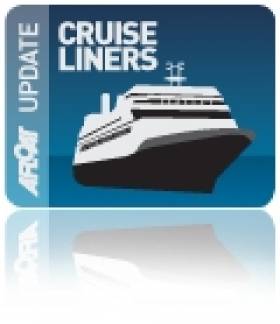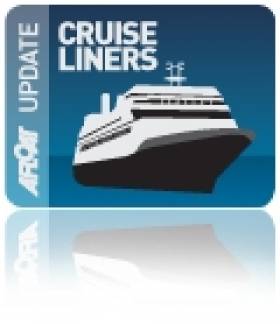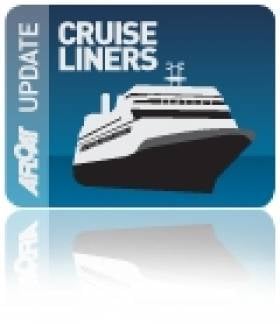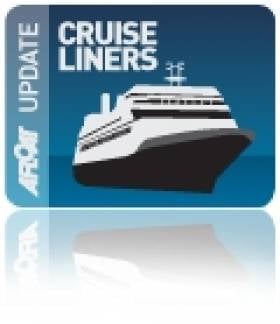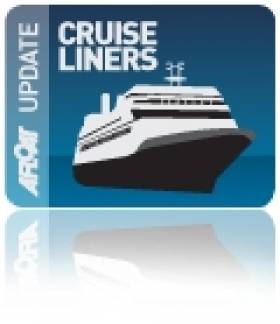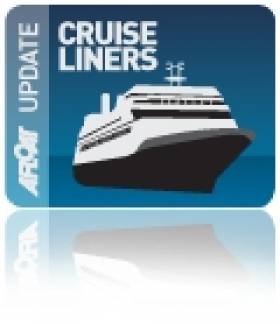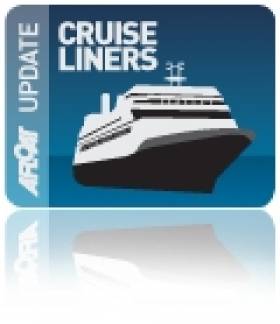Displaying items by tag: Cruise Liners
#ExploringDonegal - National Geographic Explorer visited Killybegs Harbour yesterday following a voyage along the western seaboard with anchorage calls off Aran Islands and Dingle Peninsula as previously reported here on Afloat, writes Jehan Ashmore.
The call of Lindblad Expeditions /National Geographic's operated 150-passenger cruiseship to Killybegs is the second arrival this season which was opened last week by Le Boreal with a 254 passenger capacity.
A sister of the Companie du Ponant's chic 'boutique' style mega-yacht like vessel, Le Soleal is the next caller due on 24 May. In total 9 cruiseships are scheduled in 2015, surpassing last year itself a record.
More than 6,300 passengers are to visit the town and along this stretch of the Wild Atlantic Way. The main attraction of nearby Slieve League, one of the highest sea cliffs in Europe that are 601m (1,972 ft) high above the Atlantic Ocean.
Of the P&O Cruises to visit the north-west, they will be made by the 30,000 tonnes Adonia, with a length of 180.45m (592 ft) and the largest cruiseship to Killybegs in 2015 goes to the 69,000 tonnes Oriana with a length of 260.00m (853.02 ft).
Adonia has a capacity for 710 passengers while Oriana is much greater with 1,822 passengers and a crew of almost 800.
#RoyalVisitor – Royal Princess at a commanding 142,000 tonnes is even larger than yesterday's Dublin Port record caller MSC Splendida, as this morning's latest caller made her maiden call off Dun Laoghaire Harbour by anchoring in Dublin Bay, writes Jehan Ashmore.
The 19 deck cruiseship christened by Catherine, Duchess of Cambridge almost two years ago at her UK homeport of Southampton had yesterday called to Cobh. This is where her sister Regal Princess was the first caller to dock last month after completion of phase one of Cobh's upgraded deepwater berth.She also became Belfast's biggest caller last year.
The work at Cobh Cruise Terminal is designed to accept RCI's mega sized 'Quantum' class 168,000 tonnes giants with almost 5,000 passengers in which the Port of Cork hope to attract in 2017.
It is the depth of water that restricts Royal Princess drawing 8.5 metres and those such as the 'Quantum' class from entering Dun Laoghaire Harbour.
The Dun Laoghaire Harbour Company have proposed a €18m single cruise-berth jetty as part of a 'masterplan'. The jetty would jutt out 435m and almost be in the centre of the south Dublin Bay port. The plans have been met with mixed reaction and in which An Bord Pleanala will review the planning application along with an Enviromental Impact Statement (EIS).
A similar process applies to Dublin Port Company's proposed €30m double-berth cruise terminal to enable much larger callers to dock closer to the city-centre.
As for the length of these 'next generation' cruiseships, MSC Splendida's 333 metres is a Dublin Port record and also pips the Royal newcomer by a mere 3 metres.
In the meantime Royal Princess launches the first of record 21 cruise callers this season to Dun Laoghaire bringing around 100,000 passengers and crew.
She had approached Dublin Bay from offshore via the Kish Lighthouse and North Burford before anchoring over a nautical mile of the harbour's East Pier, which offer some of the best vantage points as does Sandycove and Bulloch Harbour, Dalkey.
Royal Princess is deemed as one of the "Most Popular Ships at Sea" according to Cruise Critic and has already won five prestigious Travel Weekly Magellan Awards in the Large Ship, Atrium, Spa, Pool and Mobile App Design categories. A notably feature is the innovative SeaWalk which being hailed as one of the "Top Gee-Whiz Features at Sea" by USA Today!
Situated on top deck is the largest pool ever featured with Princess Cruises and an enhanced Movies Under the Stars screen. Those seeking a dizzying thrill, there's the aforementioned SeaWalk's of all 128 feet high offering a straight down vertical view!
Several decks below at the bow is where during this morning's anchorage procedures, a special Princess Cruises 50th anniversary flag was raised at the prow of the massive cruiseship.
As for another example of the ships dimensions, she has a breadth of 44 metres, that's four times that of the Naval Service CPV L.E. Orla (P41), a former Royal Navy coastal patrol vessel.
Her naval homeport of Haulbowline facing Cobh is where MSC Splendida today made her maiden call to Cork Harbour. She is one of the largest to visit Cobh noting the biggest albeit 'liner' status of Cunard's QM2 has called in more recent years. She made her Dun Laoghaire debut in 2013.
So when it comes to who is the Irish 'King' of the cruise crown title, this rests with RCI's Independence of the Seas of a whopping 154,000 tonnes which made her debut to Cobh in 2007.
Returning to the former Royal Navy CPV named HMS Swift she served the Hong Kong Patrol Squadron until transfer to the Naval Service in 1988. The CPV visited Southampton's neighbouring port of Portsmouth in 2013 where the RN's base nd HQ are located. Again the same year Royal Princess was commissioned into service to serve the expanding UK cruise market.
#WestIslandsCruising - Two former Norwegian 'Hurtigruten' Coastal Express Voyage ships today visited the west coasts of Ireland and the UK, where passengers on board experienced totally contrasting scenery, writes Jehan Ashmore.
Anchored off the Dingle Peninula Co. Kerry this evening is National Geographic / Lindblad Expedition cruises small ship National Geographic Explorer (1982/6,471grt) which arrived from the Isles of Scilly.
The former Lyngen which took on other names since becoming a full-time cruise ship is understood to be calling next to the stunning Skelligs that pierce out of the Atlantic.
Having boarded the 'Explorer' during an anchorage call off Inishmore, Aran Islands in 2008, the on board library been of National Geographic Magazine fame was not surprisingly well-stocked!
While making this ship visit, it was particularly noted how rebuilt the former Norwegian coastal cargo-car-carrying ferry/cruise ship had undergone conversion. The ship prior to then had served the routine Bergen-Kirkenes circuit.
The work involved a new extended aft gym structure on the top-deck. Also the fitting of a stability ducktail sponson at the stern which dipped up and down in the swell offshore of the island's Kilronan Harbour.
A Hurtigruten vessel that is currently in the fleet, Fram (2007/11.647grt) which unlike her counterparts is designed primarily as a polar expedition cruiseship was in nearby waters of the Natiional Geographic Explorer. As the 418 passenger vessel had anchored in Galway Bay off the city at the end of last month.
As for the second former Hurtigruten ship, Serenissima (1960/2,598grt) which today visited the Scilly Isles, the low-lying archipelago off the Cornish coast. This former fjord fleetmate was the Harald Jarl that in her current role had anchored off St. Mary's the main island. It is also understood she is to be making a next port of call across the English Channel to St. Peter Port, Guernsey.
Serenissima was particularly smart (see photo) when within Dun Laoghaire Harbour in 2013 and year one after the revived cruise business began. She berthed at the Carlisle Pier while on the same day of Serenissima Cruises port call in stark contrast the giant Cunard flagship liner, Queen Mary 2 anchored on her maiden call off the south Dublin Bay harbour.
This evening Royal Princess which called to Cobh is underway. It will be the turn of the Princess Cruises 3,600 passenger caller as previously reported to make her maiden visit off Dun Laoghaire Harbour in the morning.
#WatchSplendida – MSC Splendida's sheer size currently occupies almost the entire Ocean Pier quay within Alexandra Basin, where the largest and longest cruiseship in the history of Dublin Port docked today, writes Jehan Ashmore.
Towering 18 decks above the port estate and that of Alexandra Basin the main part of the port that accommodates the majority of cruisecallers. This latest record-breaking caller demonstrates how large these ships are and indeed becoming increasingly bigger!
Listed below is more detailed information of the 2009 built cruiseship completed for MSC Cruises from the yard of STX France in Saint Nazaire.
Splendid's Statistics
Gross tonnage 137.936 tons
Number of passengers 3.247 (on double basis)
Crew members About 1.370
Number of cabins 1.637, incl. 43 for guests with disabilities or reduced mobility
Length/Beam/Height 333,30 m / 37,92 m post panamax / 66,80 m
Decks 18, incl. 14 for guests
Maximum speed 22,99 knots
Average speed 18 knots
So Where to Watch the Splendida...
With all that to take on board or even from the perspective as of a spectator ashore...where are the best places to observe this latest instalment to Dublin Port representing the global cruise industry.
The best vantage point is ideally along the Great South Wall which celebrated its 300th anniversary in which the Dublin Port Company held a conference recently to celebrate the decision to built the wall. Studies from an EIS for the proposed €30m cruise terminal formed as a major part in the contents of the conference lectures.
Also included in the conference was the beach on Bull Island which too will offer views as the ship departs behind the North Bull Wall that forms the other boundary of the port channel.
What about the open stretches lining the 'Splendid' horse-shoe shaped bay notably along Sandymount Strand that forms such a unique part of this amenity of a European capital.
From here you will be able to see the 18-deck ship glide above the port's skyline as it heads down the channel along the Great South Wall and beyond the Poolbeg Lighthhouse entrance.
Or if out jogging and walkers alike can look forward to either the pierheads at Dun Laoghaire Harbour giving another view as she progresses underway in the bay. Dun Laoghaire Harbour itself is where there are also plans to accommodate such huge cruiseships within the harbour with a purpose built €18m cruise-berth jetty.
In fact the MSC Splendida was originally due to make an anchorage call today off Dun Laoghaire Harbour with passengers tendered ashore, however she is scheduled to call on the 21st May.
Noting that the even larger! Royal Princess of 141,000 tonnes with 3,600 passengers and 1,300 crew is to call offshore of Dun Laoghaire tomorrow (noted latest update on ETA is 6 am in the morning). The 2013 built Princess Cruises ship will instead launch the season as the first of a record 21 cruiseships due in the majority to anchor off the south Dublin Bay harbour.
The arrival of Royal Princess given her closer anchorage call should arguably be more impressive than MSC Splendida particularly given the vantage available from coastlines south of Dun Laoghaire.
#DublinCruiseRecord – A historic day for Dublin Port as the biggest ever ship to dock, MSC Splendida of more than 137,000 tonnes and towering 18 decks called this morning with the massive cruiseship entering the port 'stern' first or in reverse, writes Jehan Ashmore.
The Mediterranean Shipping Company's (MSC) Cruises 3,200 passenger / 1,370 crew cruiseship had sailed overnight from Greenock, on the Firth of Clyde.
Her call is another leap for the port as Grand Princess in 2004 marked a major maritime milestone as the first ship to exceed 100,000 tonnes complete with a gravity defying disco.
The MSC Splendida can boast too as she features Turkish baths!... offering the utlimate in luxury but only to those who join the MSC Yacht Club, an excusive ship within a ship experience.
MSC Splendida's maiden call to Dublin Port also became the longest cruiseship to visit at 333 metres as she ranks as the 11th longest in the world. These impressive dimensions have pushed the port's operational limits as previously explained today on Afloat.ie and below.
Currently the port can only handle ship lengths of up to 300m which is why the 'Fantasia' class MSC Splendida could not sail up the channel normally, nor be able to use the turning circle prior to entering Alexandra Basin due to the confined quay layout space on such a longer ship.
Instead, MSC Splendida was skilfully edged astern or backwards within Alexandra Basin to berth No.33. This sees the bow already face the River Liffey in readiness for a straightforward departure this evening (from 7 pm) from Ocean Pier that separates both Alexandra Basins (West where docked) and that of neighbouring East basin.
However, back in 2002, the same procedure of bringing a cruiseship in reverse through Dublin Port's entrance involved Royal Caribbean Line's Brilliance of the Seas of 90,000 tonnes that docked also at Alexandra's berth No.33. At the time the brand 'Millennium' class newbuild was also the longest cruiseship to Dublin Port at 295 metres.
Likewise of MSC Splendida, this required a lot of preparation prior to handling such a vessel despite then there being leeway in terms of length for the 'Brilliance' to swing in the turning circle leading into Alexandra Basin. It is understood however that during the call then more than a decade ago, that there was insufficient depth for the 'Brilliance' notably on the river side outside the basin to allow for safe navigation of the turning circle into Alexandra Basin.
On a related note, further dredging would be required as DPC's proposed Alexandra Basin Redevelopment (ABR) Project and associated EIS is currently under review with An Bord Pleanala. The ABR is intended to transform phase one of the port Masterplan so to allow larger and deeper drafted ships of all types, including the world's largest cruise ships, to routinely call to Dublin Port.
In the case of cruise ships, they will berth upriver at a proposed €30m double-cruise berth terminal next to the East Link Bridge along the North Wall Quay Extension. The second berth would be within Alexandra Basin which would be accessed by an expanded turning circle that faces the Poolbeg Yacht & Boat Club Marina.
The proposed terminal would handle the world's top ten largest cruise liners, including those such as Royal Caribbean Line's 360m long Allure of the Seas. This is a mega 'Quantum' class cruiseship of 168,000 tonnes and carrying almost 5,000 passengers.
As previously reported, only the Port of Cork's cruise terminal at Cobh can handle these much larger cruiseships, though the port company are not expecting such callers until the 2017 cruises season.
#CunardCapitalCall – Queen Victoria, Cunard Line's elder 'Vista' class cruiseship called to Dublin Port in the late morning today as part of a 7-night 'Lusitania Remember' commemorative cruise from Southampton, writes Jehan Ashmore.
Having sailed overnight from Cobh where the main ceremony took place, this morning she passed Wicklow Head lighthouse at some 14 knots. From thereon she gradually reduced speed on the southern approaches to Dublin Bay.
Even at 90,049 tonnes the Italian built vessel with 2,194 passengers on board the 12-deck vessel has more graceful lines to other similar sized cruiseships.
She picked up a pilot off the cutter Liffey close to the South Burford Buoy.
When she further entered Dublin Bay offshore of Dun Laoghaire Harbour, this is where an anchorage call of her sister, Queen Elizabeth first took place in 2013.
In that same season the Cunard flagship cruise-liner Queen Mary 2 made her first appearance in Dublin Bay and again on that occasion she anchored off Dun Laoghaire.
The massive 151,000 tonnes 'liner' has not visited Dublin Port either, though the largest ever cruiseship is due to visit the port, MSC Splendida of 137,000 tonnes and longest at 333m is set to call to the capital port next Monday.
The record-breaking visit of MSC Cruises 'Fantasia' class cruiseship with 3,600 passenger capacity will also be a historic maritime milestone as this will be the biggest ship of any kind to visit Dublin Port.
Should one or both of the proposed cruise-berthing facilities totalling almost €50m be given the go-ahead in Dublin Port and neighbouring Dun Laoghaire Harbour, it would only be then that even bigger behemoths of the cruise industry will be able to berth within port.
In the meantime, the 294m Queen Victoria was able to turn around within Alexandra Basin. This part of the port is awaiting An Bord Pleanala decision on the proposed €200 million reconfiguration of the west basin that includes the dedicated cruise terminal. The proposed redevelopment would also require significant dredging including the channel leading to the port.
The 'Cunarder' came alongside Alexandra Basin's berth 33. This same stretch lining Ocean Pier within the basin is where MSC Splendida will notably berth 'astern' due to the existing confines of the port layout.
Such sized cruiseships and even larger in addition to increasingly bigger cargoships cannot use the existing turning circle which dictates ultimately the size of vessel using the port.
#Lusitania100 – RMS Lusitania was given a fitting tribute in the early hours of this morning as Cunard Line's Queen Victoria took up position last night over the wreck site off the Old Head of Kinsale, where she sank 100 years ago marking the single most tragic event in the liner company's 175 year history.
The liner Lusitania left New York for Liverpool on 1st May 1915 with 1959 passengers and crew onboard.
On 7th May 1915, a single torpedo fired from the German U-boat U-20 slammed into the starboard side of the Lusitania off the southern coast of Ireland. The ship listed and sank in just 18 minutes. While 761 of those on board were rescued, most were not so fortunate.
On board Queen Victoria, passengers are taking the 'Lusitania Remembered' commemorative cruise.
As previously reported on Afloat.ie Queen Victoria departed Southampton last Sunday along with her Cunard's fleetmates down the Solent.
Before Queen Victoria called to Cobh this morning, guests were witness to dropping of wreaths and floral offerings into the sea at the ceremony held on board (SEE PHOTOS) in the early hours of this morning in addition to a number of other tributes.
A Commemorative Dinner was held last night on board and today a special service was held ashore in Cobh (Queenstown) as it was known a century ago.
At 2.10pm the Queen Victoria's whistle marked the time when Lusitania was torpedoed and this was followed by a second whistle sounded at 2.28pm to indicate how little time there was between the first hit and the ship's sinking.
Historian Eric Sauder will produce a temporary exhibition of Lusitania memorabilia that will be displayed on board Queen Victoria during her 3 – 10 May 2015 voyage. The exhibit will feature china, silver, brochures, postcards, memorabilia, and souvenirs that will bring to life the story of Cunard's flagship.
Three experts will be sailing as speakers during the cruise: maritime historian Chris Frame, Lusitania expert and owner of the Lusitania artefacts Eric Sauder and Irish Lusitania Expert Senan Molony.
#BantryBay - Sea Explorer I entered the scenic seclusion of Glengariff in Bantry Bay today and where the mere 90m vessel of 4,200 tonnes anchored off Garnish Island, writes Jehan Ashmore.
The 114 guest luxury small ship, part of the cruise agency operator Noble Caledonia fleet is according to Bantry Bay Port Company schedule to be the only caller so far listed for 2015.
Accommodation of the 1991 Italian built vessel is of 57 spacious suites and all outside with an average of 245 sq ft. Facilities offered are of a high standard albeit on board an intimate sized ship.
Yesterday she had been to St. Peter Port, Guernsey again at an anchorage along with Cunard Line's 90,080 tonnes Queen Victoria. The Cunarder had departed Southampton at the weekend to mark the start of the company's 175th anniversary with a celebratory cruise in company down Solent water.
Tomorrow she calls to Cobh on the centenary of the RMS Lusitania disaster during WW1.
Last month the Port of Cork outlined plans for Phase 1 of the Bantry Inner Harbour Development (incl 20-berth marina) which will be undertaken on behalf of its subsidiary company, Bantry Bay Port Company.
Over two years ago Sea Explorer (see photo) arrived to Dun Laoghaire Harbour albeit in a 'lay-up' mode in advance to taking up a European season with cruises starting in June 2013.
She is equipped with Zodiacs for expedition landings and for reaching isolated locations.
Another expedition / polar cruiseship Fram with 400 passengers and operated by Norwegia based Hurtigruten was understood to be the first caller to Galway Harbour this season.
The call of the Fram took place at the end of April and likewise of the 'Explorer' this involved anchoring offshore.
‘Grand’ Class Cruiseships to Dublin Port Raised the Bar Frequently Before Largest Ship Ever
#GrandClassCaller - Princess Cruises 'Grand' class Caribbean Princess of 112,894 tonnes docked in Dublin Port this morning as one of the largest ever ships to call and at a deck higher than the historic call next week of the mighty MSC Spendida set to break all records, writes Jehan Ashmore.
Despite the record-breaking visit next Monday of MSC Splendida 137,396 tonnes one should not easily dismiss today's call of the higher 19-deck Caribbean Princess with 3,142 passengers and 1,200 crew. Noting a sister, Ventura of P&O Cruises is understood to hold the current Dublin Port record at 116,017 tonnes as the largest ever ship of any type to visit the capital.
MSC Splendida is however the longest cruiseship at 333m long to visit Dublin Port. Due to the confines of quayside layout this is why the 3,247 passenger / 1,370 crew vessel is to enter stern first i.e. in 'reverse'. As currently Alexandra Basin's turning circle is too restricted to swing the vessel within port.
It was however more than a decade ago that the 100,000 tonnes milestone of any ship to enter Dublin Port was surpassed. The honour went to 'Grand' class leadship, Grand Princess of 108,806 tonnes to set that historic first in 2004. As for the sheer size of the ship, I vividly recall the scene as she glided past the Poolbeg Lighthouse under a brilliant welcoming blue sky over the port and city alike.
Then that record-breaking 'Grand' call was also particularly notable given that the owners of Princess Cruises, Miami based Carnival Corporation had a contract with Dublin Port Company to bring 26,000 passengers and 14,000 crew alone throughout the following year. At the time these cruise tourism figures were the equivalent to 10 normal cruises generating an estimated €23m to the capital's economy.
Also notable during the 'Grand's class inaugural call was the vessel's distinctive signature 'Skywalker's Nightclub'. Having boarded for a port visit, this structure seemingly perched precariously in a cradle suspended above the stern was at 18-decks high! On the 'Caribbean' this feature remains on deck 19, affording even more amazing views over the sea and port destinations visited.
Ironically, the structure of the Italian 1998 built Grand Princess was removed in recent years as previously reported on Afloat.ie. This was to improve efficiencies on operational fuel costs.
The Grand Princess current tonnage is still an impressive 107,517 and given that the class remain the most frequent and largest callers to the island for more than a decade, calling not just to Dublin Port but also Belfast and to Cork. Princess Cruises celebrates 50 years of service noting a sister brand, Cunard Line have their 175th anniversary also in 2015.
Next week's call to Dublin Port of MSC Splendida on Monday (11 May) will certainly elevate the position of the port status to accommodate much larger cruiseships given the proposed €30 cruise terminal at Alexandra Basin.
The proposed double-berth facility near the East-Link bridge would allow for even larger cruiseships to berth those been Royal Caribbean Lines 360m long mega 'Quantum' class with almost a 5,000 passenger capacity.
Add to the mix are Dun Laoghaire Harbour Company plans for a proposed €18m single cruise-berth.
MSC Splendida will make another Dublin Bay appearance albeit at anchorage off Dun Laoghaire Harbour on 21st May. Before she calls, the opening Dun Laoghaire season caller as previously reported will be Royal Princess (not 'Grand' class) on 12th May. Again this visit offshore is where tenders will cater for the 3,600 passenger capacity vessel of 141,000 tonnes completed in 2013 and which has a 1,346 crew.
Only the Port of Cork will be able to claim the ability to accommodate the Quantum class trio, when phase two of a €1.5m upgrade is completed later this year at Cobh.
As previously reported, Cobh expects to handle these massive cruiseships but not until 2017.
#dlharbour – The Dun Laoghaire Cruise Stakeholder Group will launch its 2015 cruise season today. The year is set to be the most successful cruise season for Dun Laoghaire, with an expected 100,000 passengers and crew set to arrive into the Harbour over the next five months.
Ahead of the calls, the Cruise Stakeholder Group has put in place a welcome programme which will run for each cruise call. The welcome programme will comprise entertainment, shuttle bus transport and an ambassador scheme to provide information and guidance to cruise visitors.
The first cruise visit of the season will take place on Tuesday, 12th May with the arrival of the Royal Princess. The ship will be on its maiden voyage, and will carry over 5,000 crew and passengers.
During Wednesday's launch, the Dun Laoghaire Stakeholder Group will unveil full details of its cruise welcome programme, as well as announcing key dates for major cruise calls.
Dun Laoghaire Stakeholder Group is comprised Dun Laoghaire Harbour Company, Dun Laoghaire Rathdown County Council and the local BID Company.
Speaking ahead of the event, Chairperson of Dun Laoghaire Harbour Company, Eithne Scott Lennon said: "We are delighted to be welcoming cruise visits in such numbers to Dun Laoghaire over the coming months. We are working collectively with the Council and local businesses to ensure that visitors get a taste of the local area through our welcome programme. Increased cruise visitors should provide a welcome boost to the local economy."




























